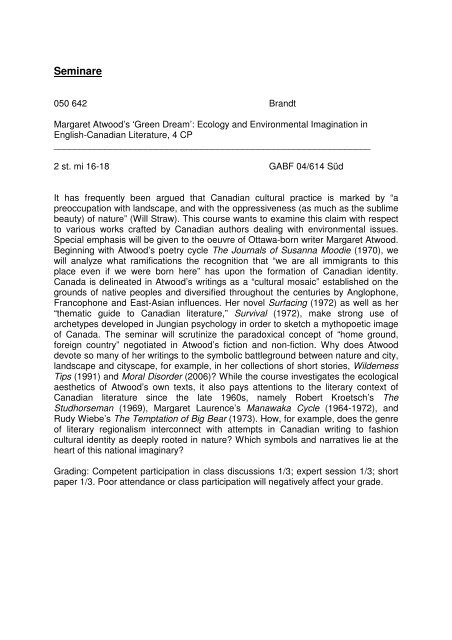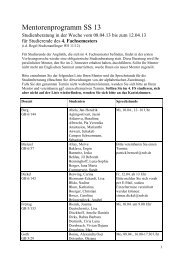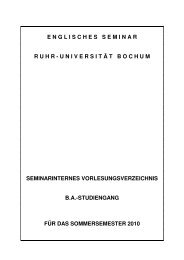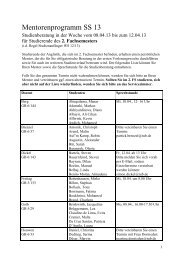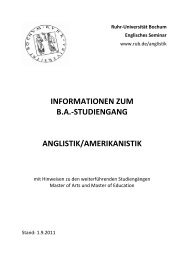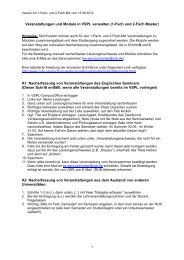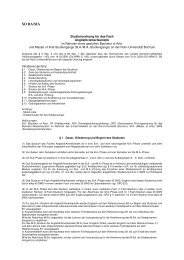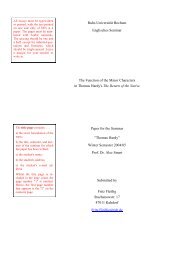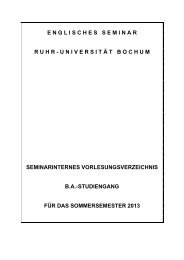gb - Englisches Seminar - Ruhr-Universität Bochum
gb - Englisches Seminar - Ruhr-Universität Bochum
gb - Englisches Seminar - Ruhr-Universität Bochum
You also want an ePaper? Increase the reach of your titles
YUMPU automatically turns print PDFs into web optimized ePapers that Google loves.
<strong>Seminar</strong>e<br />
050 642 Brandt<br />
Margaret Atwood’s ‘Green Dream’: Ecology and Environmental Imagination in<br />
English-Canadian Literature, 4 CP<br />
______________________________________________________________<br />
2 st. mi 16-18 GABF 04/614 Süd<br />
It has frequently been argued that Canadian cultural practice is marked by “a<br />
preoccupation with landscape, and with the oppressiveness (as much as the sublime<br />
beauty) of nature” (Will Straw). This course wants to examine this claim with respect<br />
to various works crafted by Canadian authors dealing with environmental issues.<br />
Special emphasis will be given to the oeuvre of Ottawa-born writer Margaret Atwood.<br />
Beginning with Atwood’s poetry cycle The Journals of Susanna Moodie (1970), we<br />
will analyze what ramifications the recognition that “we are all immigrants to this<br />
place even if we were born here” has upon the formation of Canadian identity.<br />
Canada is delineated in Atwood’s writings as a “cultural mosaic” established on the<br />
grounds of native peoples and diversified throughout the centuries by Anglophone,<br />
Francophone and East-Asian influences. Her novel Surfacing (1972) as well as her<br />
“thematic guide to Canadian literature,” Survival (1972), make strong use of<br />
archetypes developed in Jungian psychology in order to sketch a mythopoetic image<br />
of Canada. The seminar will scrutinize the paradoxical concept of “home ground,<br />
foreign country” negotiated in Atwood’s fiction and non-fiction. Why does Atwood<br />
devote so many of her writings to the symbolic battleground between nature and city,<br />
landscape and cityscape, for example, in her collections of short stories, Wilderness<br />
Tips (1991) and Moral Disorder (2006)? While the course investigates the ecological<br />
aesthetics of Atwood’s own texts, it also pays attentions to the literary context of<br />
Canadian literature since the late 1960s, namely Robert Kroetsch’s The<br />
Studhorseman (1969), Margaret Laurence’s Manawaka Cycle (1964-1972), and<br />
Rudy Wiebe’s The Temptation of Big Bear (1973). How, for example, does the genre<br />
of literary regionalism interconnect with attempts in Canadian writing to fashion<br />
cultural identity as deeply rooted in nature? Which symbols and narratives lie at the<br />
heart of this national imaginary?<br />
Grading: Competent participation in class discussions 1/3; expert session 1/3; short<br />
paper 1/3. Poor attendance or class participation will negatively affect your grade.


